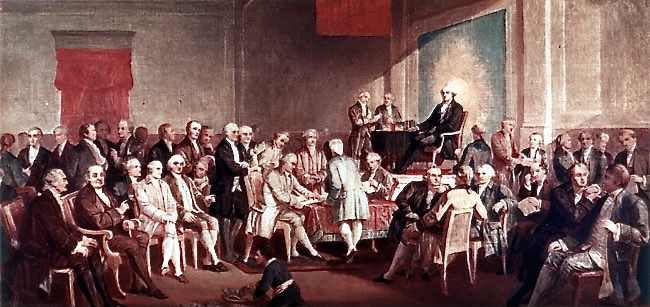Signing of the Constitution
by Thomas P. Rossiter

Artist’s Biography
Thomas P. Rossiter was born in New Haven in 1818 and died in New York in 1871. Among his famous paintings are Picnic by the Lake, The Parmly Sisters, Visit of the Prince of Wales, and Muses and Graces. His Signing of the Constitution, painted circa 1860-1870, once hung in Independence Hall in Philadelphia. According to Karie Diethorn, Chief Curator, Independence National Historical Park, the Rossiter painting has “been in the museum collection here at Independence Hall since 1875 when it was donated by the person who bought it from Rossiter. It isn’t exhibited by the National Park Service because it’s not accurate in terms of the room’s architecture or furnishings.” The Rossiter painting has been replaced at Independence Hall by the Glanzman painting.
The Painting
Rossiter’s “Signing” is similar in many ways to Stearn’s earlier portrayal and Christy’s twentieth century rendition, although Rossiter does exercise more artistic license. Thirty-nine delegates are portrayed in a room with the curtain over the window still drawn. Washington is higher than anyone else, presiding over the signing with what seems almost like a halo behind him. Due to the sunlight pouring in from somewhere behind the General, the entire setting has a bright character to it. The chair he is sitting in isn’t quite the Rising Sun chair, but it is close. According to Curator Diethorn, the Rising Sun Chair was moved from Independence Hall in 1800 and did not return until 1872.
There is one, and only one, table centrally located in the painting, where five delegates gather, busy at work. To their left are eighteen delegates, six sitting in chairs and twelve standing behind them, all looking rather content. To Washington’s right are two delegates, and to his left are thirteen, all seeming to be conversing over the Constitution.
The Delegates
How many delegates can you recognize other than Washington? Is Madison at the head of the table just below Washington? This actually would conform to Madison’s own public description of where he sat at the Convention. “I chose a seat in front of the presiding member.” Franklin and Hamilton are recognizable as two of the six people sitting in chairs to the left of the table. But, according to a key to the painting left by Rossiter, he actually placed Madison next to Hamilton, even though the person to Hamilton’s left doesn’t look like Madison! This is one of a number of possible inaccuracies in a painting that nevertheless conveys an interest in the work of the Convention. There is another oddity about this painting because there is a fortieth person present and he is not William Jackson the recorder. Rather, a younger person, clearly not a delegate, seems to crouch in the center foreground of the painting, at the delegates’ feet. What is he up to? Is he a scribe, a servant, a messenger? Despite these oddities, the Rossiter painting signifies an important interest in the decisions of the founders during a critical time in the history of the nation. Rossiter painted this portrait of the American Founding during the decade when the nation underwent a Civil War and attempted to reconstruct the South.
